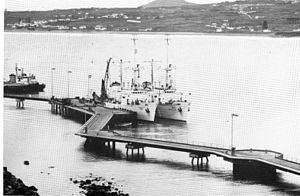Name USS Sands Construction started 23 August 1962 Length 64 m Tons burthen 1.243 million kg | Laid down 23 August 1962 Launched 14 September 1963 Tonnage 1.089 million kg Builder Point Pleasant | |
 | ||
Namesake Rear Admiral Benjamin F. Sands and his son Rear Admiral James H. Sands Sponsored by Miss Priscilla G. Sands Acquired by the Navy, 2 February 1965 In service 2 February 1965 as USNS Sands (T-AGOR-6) | ||
USS Sands (T-AGOR-6) a Robert D. Conrad-class oceanographic research ship that served the U.S. Navy from 1965 to 1973. During that period she provided valuable ocean-bottom information and underwater test data to the U.S. Navy and other U.S. agencies.
Contents
Built at Point Pleasant, West Virginia
The second ship to be so named by the Navy, Sands (AGOR-6) was laid down on 23 August 1962 by the Marietta Manufacturing Co., Point Pleasant, West Virginia; launched on 14 September 1963; sponsored by Miss Priscilla G. Sands; and accepted by the Navy and placed in service under Military Sea Transportation Service (MSTS) control on 2 February 1965, Capt. George W. Fladerer, Master.
Navy oceanographic service
Manned by a Civil Service crew, the United States Naval Ship Sands was operated in the Atlantic Ocean by the Military Sealift Command (formerly MSTS) for the Naval Oceanographic Office.
Until being placed out of service, in reserve, in April 1973, Sands performed oceanographic and marine geophysical research and conducted experiments in underwater sound propagation. For example, in the early 1970s the Sands planted large vertical subsurface acoustic arrays in the tropical Atlantic. These arrays were unique for having long term recording capabilities enabling months' long acoustic data to be collected; and for the first use of the then new material Kevlar as the strength member of the arrays. Kevlar, created by DuPont for use as cords in vehicular tires, was found to have stretch characteristics that matched those of the conductive copper wires embedded in an array. (Whereas a material like dacron can stretch upwards 50% before breaking, kevlar limits stretch to 2% before failure. This greatly reduced longitudinal stresses on the copper wires and permitted precise vertical positioning of hydrophones in the vertical string.) The Sands, during this period, also conducted acoustic data collection voyages in the area around Malta and the lower Adriatic.
Inactivation and transfer to Brazil
In 1973, Sands was placed out of service. She was struck from the Navy list on an unknown date, and, on 5 December 1990 she was transferred to Brazil and renamed Almirante Camara (H-41).
